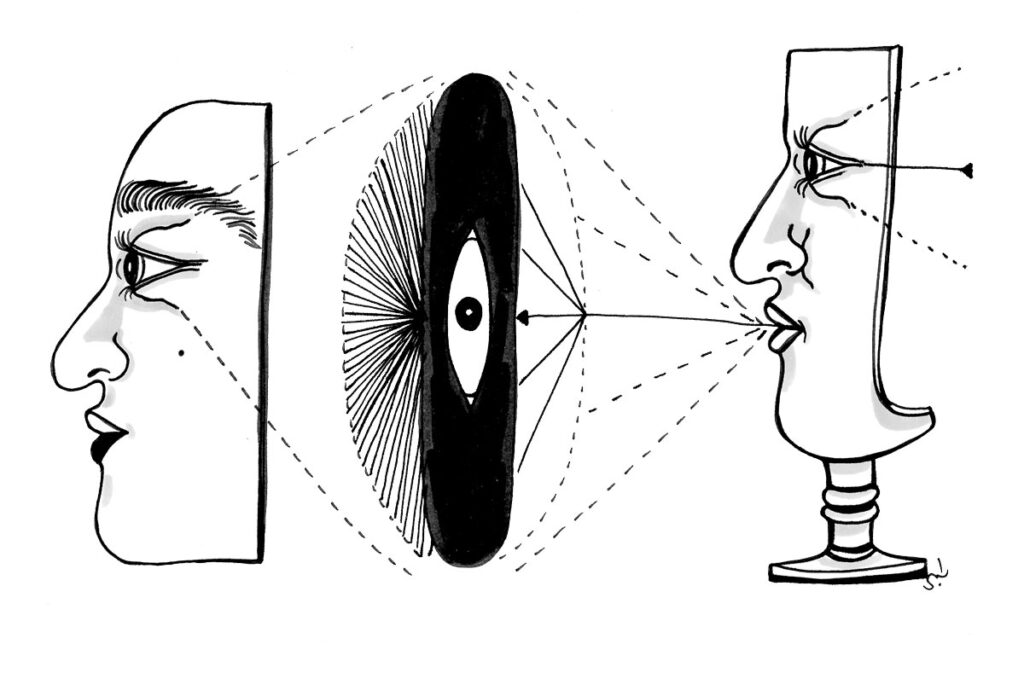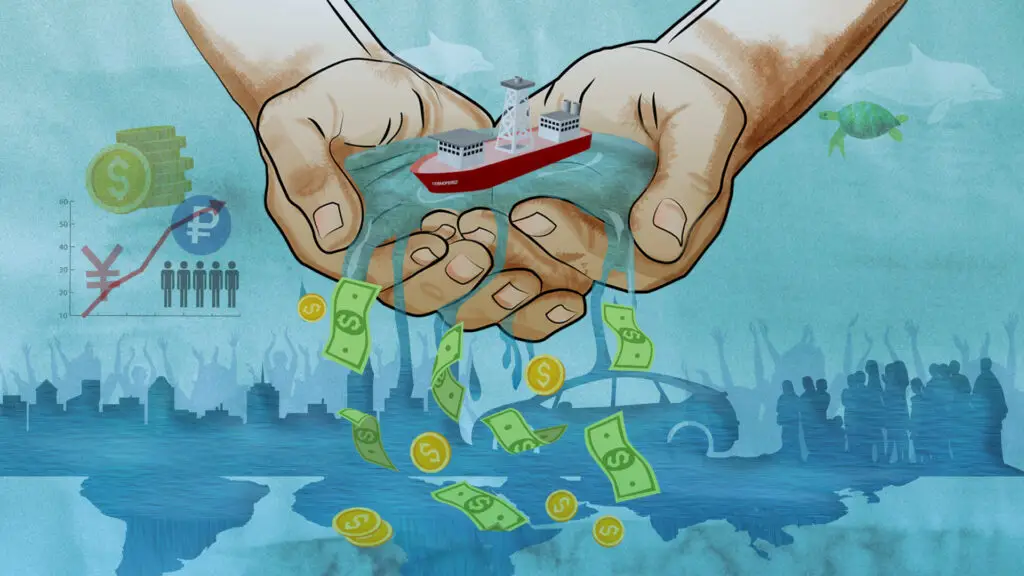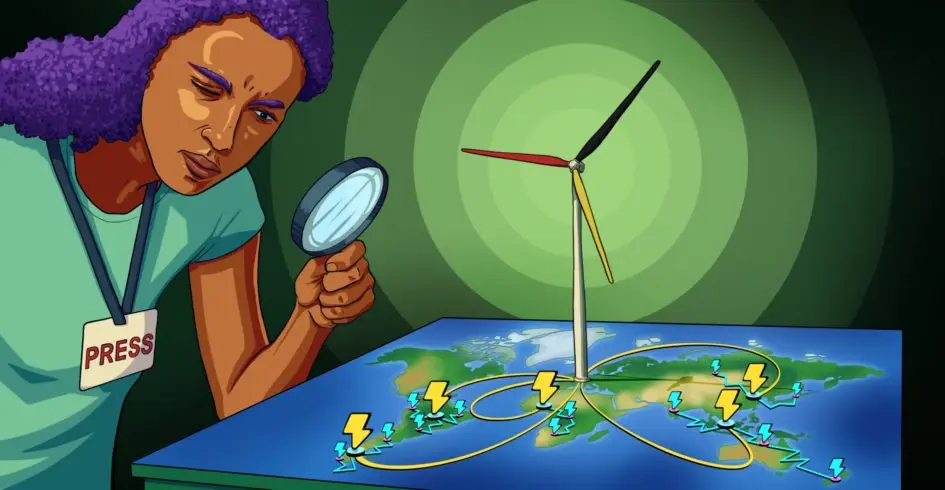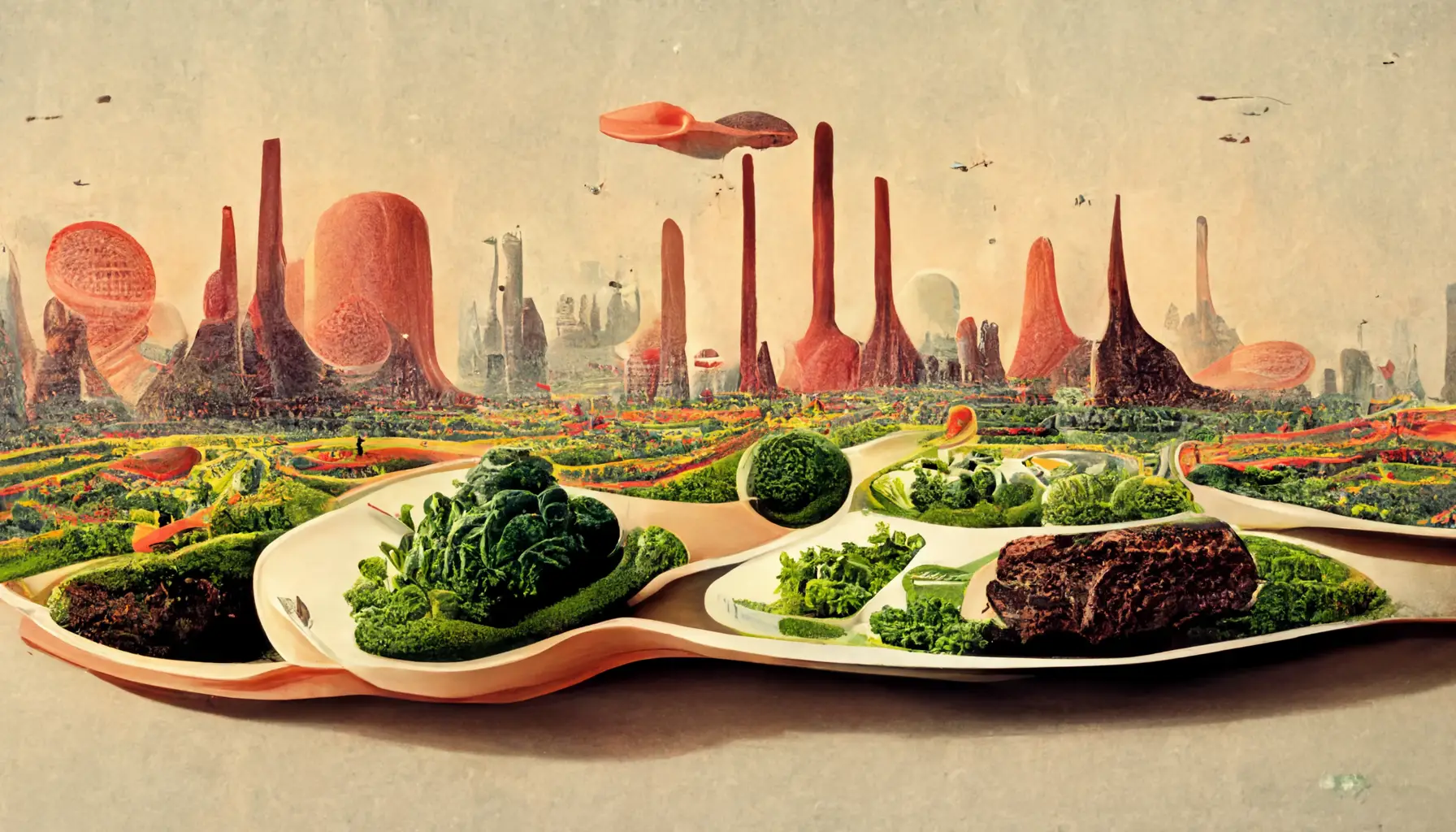
A new culture: How technology is freeing meat from a guilty conscience
- Written by Felix Austen
- Illustration by Unbias The News through Midjourney
In Singapore, you can already order chicken from a bioreactor in the restaurant. The rest of the world could soon follow. That could save billions of animals from suffering, protect the climate – and change our diet forever.
I sit in the belly of the whale and digest. It is neither dark nor damp. Rather, I am sitting comfortably dry under a massive curved construction of glass and steel, which is reminiscent of the skeleton of a gigantic marine mammal. In my stomach, pea, soy and wheat proteins are bubbling, processed by resourceful food engineers to look and taste something like pork sausage, shrimp, beef tenderloin and parmesan cheese. At least before they ended up in my stomach. So I’m digesting meat that isn’t meat in a whale that isn’t a whale.
But even though it’s all fake, somehow there’s a tangible all-hands-on-deck mood at the “New Food Conference”, to which the association Proveg International has invited me in Berlin at the end of September. The aim is for all those who are involved in the still young but rapidly growing industry of meat alternatives to come together and exchange ideas. Start-up founders will present their bacon creations with which they want to save the climate and rainforests; industry analysts quote figures that show how open people are to vegan sausages and how healthy they are.
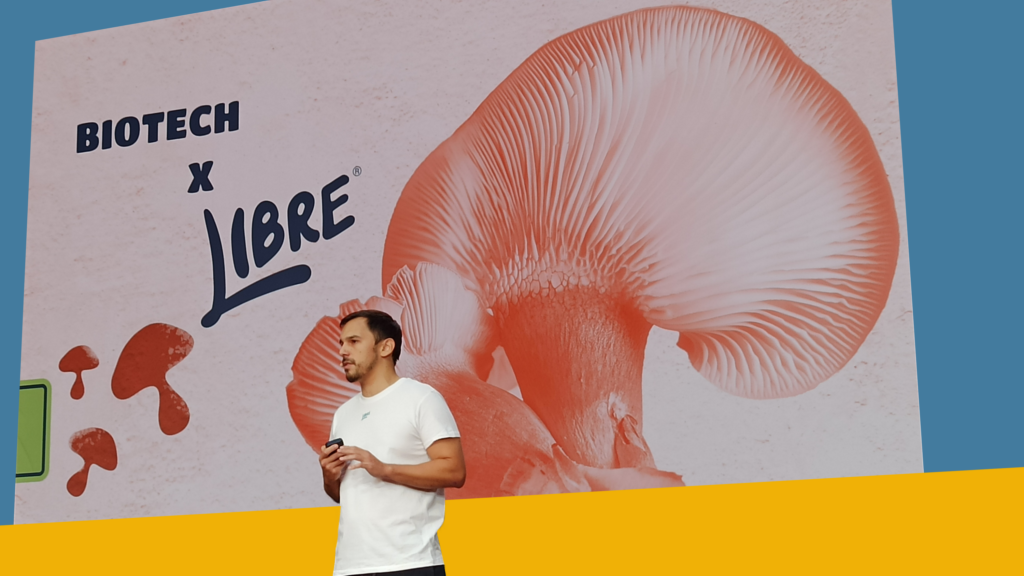
The Axico Congress Center is crammed in between the U.S. Embassy and the Adlon Hotel on Pariser Platz in Berlin, with the Brandenburg Gate a frisbee’s throw away diagonally opposite. An exclusive address that reveals something about some of the morsels served up here: There’s already decent money to be made in plant-based meat substitutes. The traditional butcher’s company Rügenwalder Mühle, for example – one of the sponsors of conference – now generates more than half of its nearly 300 million euros in annual sales with plant-based sausages.
But there is also another meat-substitute that is talked about a lot here, but of which there is nothing to see and nothing to taste. And with which, in fact, not a single euro has been earned in Europe. It is cultured meat.
Genuine meat that, in principle, does not require farm animals and grows in a laboratory instead of in a barn or on pasture.
Following in the footsteps of plant-based meat alternatives, this “lab meat” is also set to become suitable for mass consumption in the coming decades and – if the start-up founders at Axico, associations like Proveg, and climate and animal protection activists around the world have their way – will gradually displace real sausage from the counter. The consulting firm McKinsey estimates that the market for cultured meat could be worth $25 billion by 2030.
This, it hopes, could significantly reduce greenhouse gas emissions and other environmental damage from meat production and still satisfy the world’s growing hunger for meat and animal products. What the chances are that this will succeed is what this text is about.
What is cultured meat?
You could say: Meat alternatives are to the food revolution what the e-car is to the transport revolution. A technological solution that simply continues the status quo in a more “green” and sustainable way. A solution that does not require the masses to make any sacrifices and does not challenge any habits. And as with the e-car, despite all the lingering criticisms, that is precisely where the strength of meat alternatives lies. The Good Food Institute – a donor-funded non-governmental organization – has made it its mission to promote research into alternative proteins and their dissemination to the marketplace. The organization’s mission statement states:
"We will make more progress by changing the default choices than by trying to change every single person’s mind."
Mission statement of the Good Food Institute
In other words, technological progress instead of appeals to a good conscience and hopes for insight. To get my bearings in the still young industry, I talk to Ivo Rzegotta from the Good Food Institute (GFI), whom I meet over a bowl of coconut yogurt at the New Food Conference and who later answers my questions again in a video call.
Rzegotta used to work in the aviation industry, he tells me. Perhaps that’s why he’s comfortable with this more pragmatic technology- and market-based approach to reducing the environmental impact of our food.
Because there are still so many different terms for bioreactor-grown meat – cultured meat, in vitro meat, clean meat or lab meat – I first want to know if there is already a favorite in the industry. Each term has advantages and disadvantages, he says. “Some say clean meat. It’s simple, but it suggests that animal meat is dirty and makes it difficult to get through to everyone with it.”
In vitro and lab-grown meat sound like artificial products and are misleading because, after all, the product is manufactured not in a lab but in a tank more akin to a brewery’s kettle, he says. “In English, the term cultured meat is increasingly gaining acceptance, which we also consider suitable.” In German, too, various studies have shown that the term cultured meat comes closest to meeting the various requirements for a suitable term.
If you believe the promises of the start-ups, cultured meat is indeed a promising technology. But just as great as the potential are the challenges that the industry still has to conquer in the coming years.
First, it helps to understand how the meat is cultured. This is done in so-called bioreactors, large stainless steel vessels that contain conditions where living cells really thrive. In the case of cultured meat, these are mainly muscle and fat cells. The conditions are similar to those that prevail in the body of a living organism, such as cattle: Temperatures of around 37 degrees Celsius, plus a nutrient solution in which glucose as an energy carrier and other components such as proteins, vitamins and other nutrients are floating around in the right concentrations. In addition, there is plenty of oxygen, which the cells need to “breathe” for their metabolism.
Muscle cells now grow in this solution, which are in principle identical to the meat on the bones of a cow, pig or chicken. Only without the animal on which it matures. The process takes place in 2 steps:
Initially, stem cells, which are poorly differentiated cells that can divide and proliferate well, keep multiplying and growing into a biomass. Then, if the meat breeders change the chemistry of the nutrient solution in a certain way, they send a signal to the cells to stop dividing and differentiate instead. That is, to form from stem cells into the corresponding muscle or fat cells that make up meat.
After 2-8 weeks, the meat has thus grown to maturity and can be harvested.
Cultivated meat is (almost) animal free

One obvious advantage of the technology over traditional meat production is that it requires almost no animals. The ethical problems associated with factory farming are almost completely eliminated. “Almost” and “nearly”, because the stem cells that are at the beginning of the multiplication process have to be taken from living animals.
The Dutch company Mosa Meat, arguably the largest cultured meat company in Europe, claims it can eventually produce 80,000 burgers from a cell sample the size of a sesame seed. These tiny samples can be taken from the muscles of animals with local anesthesia. So, in place of mass slaughter at the slaughterhouse, the procedure would be more like an occasional blood draw at the veterinarian’s office. Only a tiny fraction of farm animals would be required compared to conventional animal husbandry, and these would then serve as stem cell donors. Creating excellent husbandry conditions for these animals would be much easier and less expensive due to the small numbers involved.
The technology thus manages with far fewer farm animals - but not totally without.
The nutrient solution in which the cell flesh proliferates also plays a decisive role. Similar to many applications in the pharmaceutical industry, so-called calf serum was used for a long time for this purpose; a liquid that is taken from the hearts of unborn calves. This serum contains nutrients that enable stem cells to proliferate optimally. That it is neither sustainable nor ethically superior to use such calf serum to produce cultured meat on a large scale is obvious. However, several companies now credibly claim to achieve good results with a serum-free nutrient solution.
How environmentally friendly is cultured meat?
The Good Food Institute has commissioned the independent Dutch research institute CE Delft to study the actual environmental and climate benefits of cultured meat when production begins on a larger scale. In the study the researchers created different scenarios based on the following preconditions:
- In order to obtain the most realistic results possible, the researchers drew on the databases of various companies that they had collected in laboratory practice in the production of cultured meat over the past few years.
- To demonstrate the potential benefits of the technology, the study’s creators compared the production of cultured meat with that of beef, pork and chicken meat from conventional livestock farming.
- To obtain values for an industrial scale, they simulated conditions that are likely to prevail if a company produces 10,000 tons of the product in 2030.
- Industrial meat production has a problematic impact on numerous environmental factors, including water consumption, land use and particulate matter emissions. To facilitate comparison, the scientists summarized the environmental impacts into a single variable that combines all of these values. This environmental variable is called “environmental impact”. It does not include greenhouse gas emissions, which are important for showing the climate protection benefits of the technology. These emissions are presented individually.
- Because the energy consumption of bioreactors is quite high, the researchers studied the climate and environmental impacts both for completely renewable electricity from wind, solar and hydropower and for an electricity mix with more fossil fuels.
The result shows that especially the production of beef is extremely harmful for climate and environment. For example, cultured meat produced with renewable energy produces 92% less greenhouse gases than conventional beef. In the case of an electricity mix using coal and gas, still 55% less CO2 equivalent. In the case of chicken and pork, small advantages remain with renewable energy, but with conventional energy, cultured meat would be at a disadvantage.

What is important at this point: For the emission values and environmental impacts of conventional meat production, the study assumes significant improvements by 2030 compared to today. If these improvements in agriculture and livestock production do not occur, cultured meat from renewable energies would be superior to “normal” meat in almost every case.
There is a third major advantage, besides ethical and environmental, that cultured meat has over animal agriculture: Production is likely to come close to eliminating the use of antibiotics, as it is much easier to create a germ-free environment in laboratory-like conditions. This should significantly slow the emergence of new antibiotic-resistant germs.
Cultured meat could also reduce the risk of diseases spreading from animals to humans.
Whether the plants will actually manage completely without antibiotics will probably also depend on their size. And there are a number of very different approaches at the moment. The U.S. start-up Eat Just, for example, is going all out for size: In Singapore, the Californian company is currently building the world’s largest factory for its vegetable egg substitute made from mung beans. Thousands of tons of plant-based eggs are to be produced here every year.
But while plant-based alternatives have already gained a global foothold, Eat Just and its subsidiary Good Meat are also taking the super-size route in the production of cultured meat. Large factories for cultured chicken meat are currently under construction in both Singapore and Qatar, with the first “harvests” due as early as 2023. On this scale – the plant in Singapore is to have the area of half a soccer field – it remains to be seen whether the plants can manage without the use of antibiotics.
Other startups see more of an opportunity in operating the bioreactors in smaller units, distributed in a decentralized manner. For example, a supermarket or even a residential building could have its own small meat factory in which local specialties are grown and the revenues also benefit more people than in large central plants. This is very similar to the energy transition.
These hurdles still separate cultured meat from the mass market
The industry is largely unanimous on the question of the biggest challenge facing cultured meat on its way to the mass market: price. At the same time as the environmental study, the Good Food Institute also commissioned a study from the CE Delft research institute to look at techno-economic scenarios for cultured meat. In it, they note that cultured meat is currently about 100-10,000 times more expensive than conventional meat. This is not surprising at first, since artificial meat is currently still produced in tiny quantities in the laboratory, while animal husbandry is a highly subsidized mega-industry.
In the best-case scenario, the study’s authors see the price of a kilogram of cultured meat falling to $6.43 by 2030, which would make it quite competitive with conventional meat.
Forecasts on the market volume of cultured meat vary widely. We expect cultured meat to hit the markets in the second half of this decade, but it will take until the 2030s for cultured meat to reach a larger share of the overall market. But once that tipping point of cost parity is reached, it can also grow exponentially and go very, very fast.
Ivo Rzegotta of the Good Food Institute
In order to achieve this cost reduction, the industry must primarily turn 4 adjusting screws, according to the study:
-Reduce production costs and the cost of nutrient solutions. A lot of this depends on scaling, i.e. the fact that the cost of a certain quantity automatically falls as production increases. At the moment, this part accounts for by far the largest share of the costs and will accordingly achieve the greatest savings.
-Investment costs would have to fall, and investors lower their typical return expectations.
-Prices for the bioreactors and associated technology would have to continue to fall, which should also occur as the market grows.
-Since energy costs in turn account for a high proportion of production costs, the availability of renewable electricity and heat affects the price of the end product. The connection with local renewable energy plants could be profitable for producers of cultured meat, the scientists believe.
Large investments in technology are necessary. At least from the private sector, there are signs that this is coming: In 2020, significant sums flowed into what are now around 100 industry startups worldwide for the first time, at around 410 million U.S. dollars. In 2021, the figure was already 1.376 billion U.S. dollars – a value that was almost reached in the first half of 2022.
If meat from a laboratory were to cost as much as meat from a barn in the future, what would consumers choose? According to surveys by the market research company Innova Market, there are many indications that suggest that a majority of people are open to cultured meat. According to a survey, one in three of those surveyed in the 10 to 25 age group already consumes meat alternatives on a daily basis, i.e. currently mainly plant-based substitute products.
After price, health, environmental factors and taste are considered the most important factors in the purchase decision. While the alternatives tend to perform significantly better in terms of the environment, the picture is currently more differentiated when it comes to health and taste, although there is a good chance that the cultivated alternatives will also come out on top here in a few years’ time.
That’s partly because culturing animal tissues not only enables cultured burgers or cutlets as new products, but rather adds a whole new range to food engineers’ toolbox. “We will very likely see cultured meat not in its pure form at the beginning, but in hybrid products – for example, plant-based meat with cultured fat as a flavor carrier,” says Ivo Rzegotta.
This has many advantages: Vegetable proteins are cheaper, often healthier and usually ecologically superior. But making meat from them can sometimes be quite difficult. Especially when it comes to more complicated consistencies and flavors than in sausage or burgers. At this point, for example, cultured animal fats could complement an otherwise vegetable product and provide the typical taste and familiar mouthfeel familiar from real meat. A breakfast bacon would be conceivable whose meat component consists of wheat or pea protein, for example, but whose white bacon layer is “real” cultured pork fat.
For some time now, veggie startups have been cutting their teeth on bacon. The Spanish founding team of Libre Foods, which uses ingredients from mushroom mycelia, is taking a new approach. To show how real their plant-based bacon tastes, they have a moving kitchen slide onto the stage at the New Food Conference and – when the stove finally warms up – start sizzling. Then a series of testers from the audience are allowed on stage.
"A lot of umami," marvels one taster. "Like the real thing," smacks another. The fat component used to achieve this flavor, the young Spanish entrepreneur reveals, is olive oil.

Looking beyond the plate: Where the meat revolution begins
If you type “cultured chicken” into Google, you are very likely to land on reports and news from Singapore. That’s because the small Asian country has become a real-life laboratory for cultured meat in recent years; as early as the end of 2020, the government became the first country in the world to allow the sale of cultured chicken meat.
The fact that the government has opened up to reactor-grown meat so quickly and so early is also due to the fact that the city-state of Singapore currently has to import much of its food. That is set to change: By 2030, the country wants to produce 30% of its own food to be less dependent on other countries and vulnerable to supply chain disruptions. Cultured meat is one piece of the puzzle of the “30 by 30” plan.
Israel, which is also small and imports a lot of food, also has some promising startups in cultured meat. The fact that the country has long established itself as a high-tech location and is known for its diverse cuisine influenced by many influences may have done the rest.
“Politicians in Israel are so open to cultured meat that they even promote it, and it should only be a matter of time before it is approved for sale there,” says Ivo Rzegotta.
In the USA, the company Upside Foods, in which billionaires Bill Gates and Richard Branson, among others, have invested, has already been able to offer cultured chicken meat for tasting. A circumstance made possible by appropriate regulations, and as early as the end of this year or the beginning of the next, the first cultured products could be approved in the USA.
And in Europe? Here, Switzerland and Great Britain could be the pioneers, promptly creating the necessary framework in which companies can gain initial experience of how their customers react to cultured meat. But why these two countries of all places? Of course, they are not or no longer in the EU. Because in the EU, novel foods must be approved under the Novel Food Regulation. Novel foods are all foods that have not been regularly eaten in Europe before a cut-off date in May 1997. That includes cultured meat. And so up until now, it is not allowed to import, sell or eat cultured meat.
So that's also why at the New Food Conference everyone talks about cultured meat, but there's nothing to eat of it. It is not allowed!
But we are still allowed to try some innovations that are not yet available in every supermarket – all purely plant-based, of course. There is Parmesan made from potato starch. It tastes spicy, but like cheese? Also interesting is the “beef filet” from Redefine Meat, who also dare to attempt the complex, fibrous structure of a beef filet, which seems to me well done. At the table opposite, Munich-based start-up Happy Ocean Foods offers its vegetable shrymp, and I’ll say this: at least they’ve managed to get the shape of a real shrimp to some extent.
In the end, however, I always find myself in front of the sandwich toasters of the Simply V employees, whose products I can also buy in the supermarket, but who have won my heart with their simple almond-based cheese toasts. And not only because they offer the only bites that really fill you up. What’s available at the Rügenwalder stand is now familiar from the refrigerated section of the supermarket.
But of course, the companies that produce cultured meat would also like to gain a foothold in Germany and the EU. To do so, they have to apply for approval of their products, “which is expensive and time-consuming,” Ivo Rzegotta tells me. The companies usually have to involve lawyers and commission expensive expert opinions. In addition, the possibilities for readjusting an application once submitted to the proper authorities are very limited.
All this is necessary so that a new food product is first evaluated by EFSA, the European Food Safety Authority, which primarily assesses the safety of the product. If the product is found to be safe, representatives of the member states must also agree in the so-called PAFF Committee. Other factors may also play a role here: The Italian and French governments have already voiced criticism of the technology, probably for cultural and traditional reasons. The coalition government has included a sentence in its coalition agreement that makes the industry confident that Germany would probably also support the approval of safe products here:
"We strengthen plant-based alternatives and advocate for the approval of innovations such as alternative protein sources and meat substitutes in the EU."
From the coalition agreement of the traffic light coalition
The fact that Germany is quite open-minded on these issues “can also be observed in plant-based products,” says Ivo Rzegotta.
“German consumers have always been open-minded, and Germany is now one of the world’s largest markets for plant-based products. Previous governments didn’t promote plant-based options, but they didn’t put any major obstacles in their way either – if you ignore the fact that plant-based dairy products are still disadvantaged in terms of VAT.”
At the moment, there is no application process underway in the EU, Rzegotta says. “But there are currently quite a few companies preparing to submit applications to EFSA for the European market. Some of them are already very far along, Mosa Meat from the Netherlands, for example, or Bluu Seafood from Germany.”
Despite the success of Bluu Seafood and a handful of other companies in the field, Germany tends to lag behind in the number of startups overall, which is also due to a lack of funding. However, there is a lot of money to be made by German companies in the future in a sector that is likely to grow strongly with the market for cultured meat; many well-paid jobs are conceivable, for instance in mechanical engineering. German companies such as Merck from Darmstadt have already been earning significant money with the construction of bioreactors and nutrient solutions, albeit in the pharmaceutical sector. Merck has long noticed that this sector has a lot in common with cultured meat – and is already investing.
Perhaps they will help to ensure that we will be able to taste some more genuine fake meat at the New Food Conference in just a few years’ time. The belly of the whale, however, may remain fake.

This project was funded by the European Journalism Centre, through the Solutions Journalism Accelerator. This fund is supported by the Bill & Melinda Gates Foundation.
Please consider a donation to support the work of our all-women newsroom. We create a space for journalists facing structural barriers, working towards a more equitable, inclusive world of journalism. Join our mission today!








